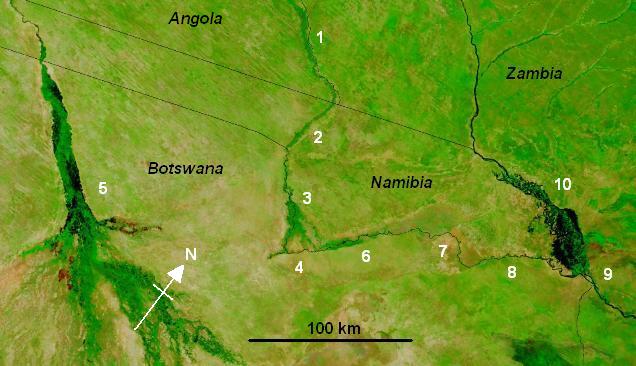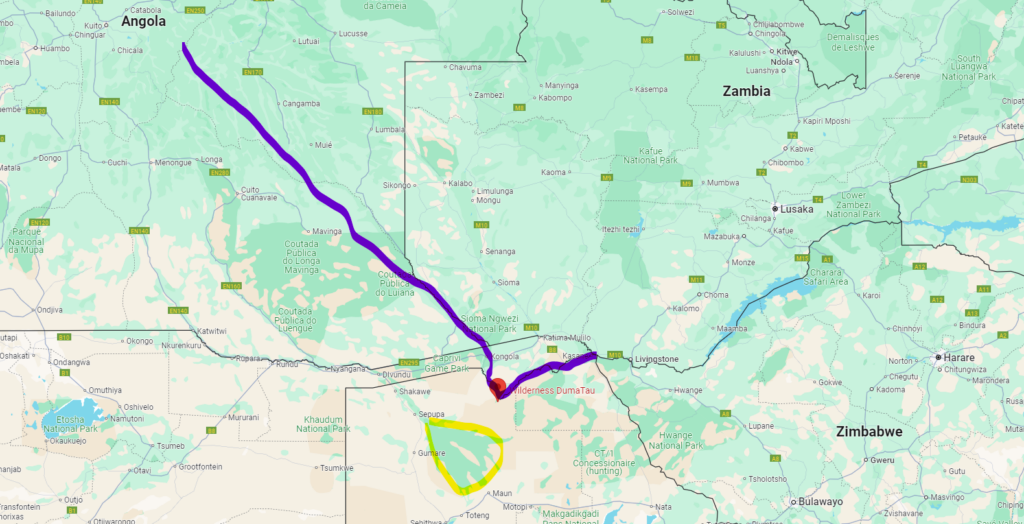Sunday, July 28, 10:30
I’ve been bad about journaling. But the experiences have been so much about visual and aural stimuli that it’s so hard to translate them into words.
I’ll write a little about our routine, which is slightly different here at Pelo camp than it was at Qorokwe.
Morning
We wake up early. At Qorokwe, breakfast was at 06:00 and we set out on game drives at 06:30. Here at Pelo it’s a half hour later. And here there are different activities: drives, boat trips, and mokoro, which we haven’t done yet.
This morning we had a boat safari. We got back at around 10:00. The drives at Qorokwe lasted longer, and by the time we got back, it was nearly brunch time. This morning they are serving brunch at 11:00. Yesterday, since we didn’t arrive until later, they had lunch ready for us at 13:00.
Food
Meals have been excellent. For breakfast there are always cold options (cereal, fruit, muffins, yogurt, cheese) and eggs to order with meat. Lunch at Qorokwe varied. One day it was assemble-your-own-pizza; other days they served combinations of salads.
High tea is served each day at 15:30, just before we head out on our afternoon excursion. There are a few light snacks, both sweet and savory, and hot and cold drinks. At Qorokwe this was also time to select our dinner options: starter, main, and dessert.
Siesta
After lunch and before tea, we have a few hours for siesta. This is also that hottest time of day. (It hasn’t generally been too hot, although it did get into the lower 90s at Qorokwe.) Since morning drives start so early, the nap is much needed, but there’s also time for reading, sorting through photos, and journaling. (Though obviously the journaling part hasn’t been a high priority.)
Excursions
Whenever we depart on an excursion, members of the camp staff wave good-bye, and they are there to greet us on our return with damp towels to wipe our faces (hot or cool depending on time of day).
We normally take a break in the middle of each excursion to get out of the vehicle and stretch our legs. Our guide (Brave at Qorokwe, Chaps here at Pelo) serves a beverage and snack. Brave always timed our afternoon break right around sunset at a spot where the setting sun created a magnificent effect.
Did I mention the hot water bottles warming our seats and our blankets in the morning? Also in our beds at night.
Evening
When we return from our afternoon game drives, it’s just about dinnertime. At Qorokwe we ate at separate tables, so there was not so much interaction with other guests. Here at Pelo, we have communal dining, and I’m enjoying having wide-ranging conversations with the other guests. At Qorokwe there were several large groups and a few couples. (I previously mentioned Ann and Elliott, who we shared a couple of meals with.) Here there was a couple from California who departed this morning, a younger Chinese fellow traveling solo, and a family (husband, wife, and college-age son) from Switzerland.
Meals here are served buffet style. At Qorokwe, servers brought us our food.
It’s just about time for brunch. More later!
But first, here’s a video tour of Pelo Camp.
Wednesday, July 31, 14:20
Somehow journaling seems to be my lowest priority. Organizing photos, doing the Wordle and Spelling Bee, posting to Facebook, and sleeping or napping or just resting have all become more important. I can’t even remember where I left off.
Oh yeah, I was describing the routine. That was Sunday morning.
Sick
Monday was a bad day for me. I think I had too much to eat and drink on Sunday night. Or ate something bad. Or just caught a bug.
I woke up at 02:00 feeling sick to my stomach. I managed to sleep a little more, but finally woke up and puked. Thinking a cup of tea would help, I went to breakfast, but I couldn’t even get that down. I went back to our tent, skipped the morning game drive, and slept some more.
Then came the diarrhea.
I ate some crackers for lunch and felt good enough to go out on the afternoon boat ride. But I still had some diarrhea, plus I developed a cough (I think from the stomach acid burning my throat when I puked).
I slept with a towel stuffed into my shorts to avoid soiling my last clean pair of underwear…
Tuesday I woke up feeling much better.
Game drives
Going out for two game drives or water activities every day seems like it could get tedious or repetitive or ho-hum. But this is our eighth day, and I still look forward to each outing. Yes, we often see a lot of the same animals we’ve already seen, but there’s always something new, whether it’s an animal we see for the first time or a familiar animal exhibiting behaviors we haven’t observed before.
This morning, for instance, in addition to three or four first-time bird species, we saw hippos out of the water for the first time.
I was glad I was feeling well enough to go out on the boat ride Monday afternoon. We got to see two bull elephants playing a game of one-upmanship, bullying each other for dominance. And we saw one of the prettiest birds of the trip, a white-fronted bee-eater.
Then on Monday night we had dinner around a firepit and got a pre-dinner show from the staff.
Duma Tau
We’re now at our third camp, DumaTau. This is a top-end camp, like Qorokwe. We originally booked into three more basic camps, but we got upgraded on two of them because the original camps were closing for maintenance during our visit. Was this every a stroke of good fortune! Our room at DumaTau is huge and beautifully appointed, with all the amenities you’d expect at a 5‑star hotel. The food is excellent, and everything is included.
Even at Pelo, the one camp where we didn’t get upgraded, the service was great, and there was a never-ending supply of food and drink.
Of course, maybe that was a contributing factor to my illness.
About this post
I didn’t blog during this trip, but I kept a journal. All my posts consist of journal entries I wrote during the trip and transcribed into this blog after I got home, with some editing and embellishing.
I got behind in my journaling at Pelo and DumaTau. What you see above is all I wrote while I was there. Not very much.
Below are more photos from my time at these two camps with some additional narrative to fill in the gaps.
Photos
Saturday, July 27
The half-hour flight from Qorokwe airstrip to Jao airstrip (Jao is the name of the concession that includes Pelo Camp and a few others in the vicinity) provided a revealing picture of the different water level as we headed farther north into the Okavango Delta.
On the way from the airstrip to camp, there was a lot to see.
Sunday, July 28
This morning we went out on a boat safari.
Monday, July 29
This was my sick day, so no photos from the morning. We did a boat safari in the afternoon.
Tuesday, July 30, morning
This was our sixth day in Botswana. We spent three days at Qorokwe looking for leopards, and three days at Pelo, and finally, on the way to the airstrip for our flight to DumaTau, we found one.
Then we flew about a half hour to Linyanti airstrip, where DumaTau Camp is located.
After we arrived at camp, we had lunch and met some of the local residents.
Geography Lesson
DumaTau camp sits on the south bank of the Linyanti River, which is part of an extensive system of rivers and swamps. It starts in Angola as the Kwando River, which in rainy season is more like a swampy marsh and in dry season can disappear. The Kwando become the Linyanti, which becomes the Chobe, which either dissipates into the desert or flows into the Zambezi, depending on how much rain there is.
It’s easiest to describe this with a satellite photo from Wikipedia (Rexparry_sydney, CC BY-SA 3.0 http://creativecommons.org/licenses/by-sa/3.0/, via Wikimedia Commons):

DumaTau Camp sits roughly where the #4 is located on the map. Our previous camps (Pelo and Qorokwe) were in the Okavango Delta. Pelo was in the midst of the dark green area; Qorokwe was probably at or just below the bottom of the photo.

In any case, while the land to the south of DumaTau Camp is dry, we were right on the edge of the river, so we could look out at scenes like the elephants above right from our cabin.
Tuesday, July 30, afternoon
We set out on our first Duma Tau game drive at 16:00. But first was high tea.
Our first encounters were with birds.
And before long, we came across this fellow.
Wednesday, July 31, morning
Wednesday, July 31, afternoon
This afternoon we went on a boat ride on the river.
Wednesday, July 31, nighttime
First, dinner.
And then a night drive. Again, it’s hard to get good photos at night.
Thursday, August 1, morning
This morning’s game drive was interesting. The first two hours were kind of annoying, to be honest, but also impressive. And then I enjoyed one of the highlights of the entire safari experience.
Mary Ann was having some “digestive upset,” so I went alone with our guide, Tom. We started off heading away from the river after all our previous excursions at DumaTau were in or along the river. Soon we spotted this bird, one I hadn’t seen before:
Then Tom stopped the vehicle and pointed out a pair of lion tracks. And he suggested we follow them.
Lion hunt
Little did I know it would take nearly two hours. They took as back toward the river. We passed a dead hippo lying upside-down with its feet sticking up out of the water. And we passed the site of the red lechwe carcass, which was now gone, as was the leopard. Tom said most likely the lions chased away the leopard and finished off the meal.
Finally we found the lions, quite a ways downriver.
I admit I was very impressed by Tom’s tracking skills. I thought for sure he’d lost the trail several times, but he kept picking it up again and it led right to them. But it was a long and mostly dull drive.
African wild dogs
However, it led to something very cool. Because not far away Tom caught sight of some vultures circling.
They were waiting alongside a den of African wild dogs. Only the puppies were in the den along with one watchdog (Tom referred to him as the “babysitter.”)
Watching this all unfold was one of the most interesting things I saw during the entire time in Botswana. So I forgave Tom for his relentless lion hunt.
Thursday, August 1, afternoon
This afternoon’s “drive” was a barge excursion on the river. And by “barge,” think more Cleopatra than cargo.
The goal wasn’t to see lots of wildlife, though I did capture first-time photos of some bird species.
On our way back to camp after the cruise, our parking space had been taken:
Friday, August 2, morning
Time to move on. But on our way back to the airstrip, we still had opportunities to see birds and animals we hadn’t seen before.
Soon we were at the airstrip, and then on our way to Kasane International Airport, in the northeastern corner of Botswana.


Leave a Reply